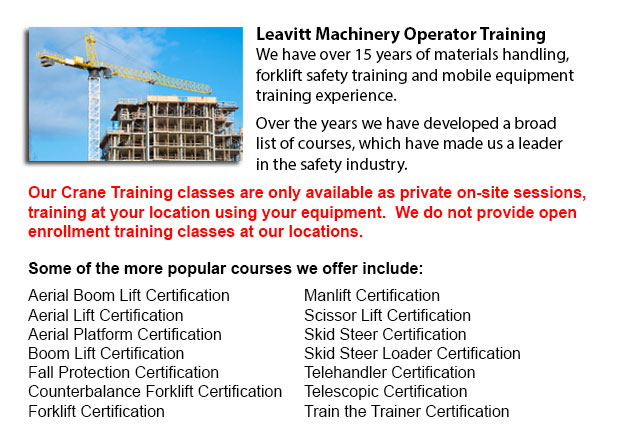
Oakville Overhead Crane Operator Training - The program teaching overhead crane operator training has been designed specifically to instruct trainees on the basics of pre-shift inspections and overhead crane/sling operation. The courses are instructed by expert trainers and consultants. Well-trained staff are more productive and efficient, which saves on costs associated with property damage, product damage, and accidents because of the utilization of incorrect operating procedures. Our overhead crane certification is customized for employees who have literacy barriers, reducing certification time by 50 per cent.
The overhead crane has been built to be used performing repetitive lifting activities. This particular type of crane could be utilized in various capacities. They may be utilized for specialized lifting tasks like for example installing or removing major plant equipment.
To safely make use of an overhead crane, workers need to employ safe rigging practices. This requires both practice and knowledge. The load must be rigged properly to ensure its stability when hoisted. Prior to starting a lifting task, it must be determined that the crane is suitable for the job, with correct capacity, travel and lift. The crane should be subjected to a thorough physical and visual check before use. The capacity of all equipment, including the hardware, rope and slings, should never exceed load weight capacities.
Prior to utilizing the rigger must know which sling is best for each and every lift and should inspect the rigging hardware and gear. The communications which are used with the crane operator should be concise and clear. A signaler needs to be designated for the role and signals should be agreed upon. The operator of the crane must follow instructions from the designated person only. If a wired or remote controller is being utilized, the operator should be trained in all its functions.
Before whichever lifting begins, the path of the load should be cleared of all hazards and a warning sign should be issued to be able to ensure the safety of the employees. Pedestrian are not under any circumstance allowed to walk underneath the lift loads. The crane hoist should be centered over the load before hoisting in order to prevent swinging. The safety catch has to be closed immediately after sliding the sling fully onto the lifting hook. Unused sling legs should be secured so they do not drag. Never leave loose materials on a load being lifted. Watch that hands and fingers are clear when slack is taken out of a sling. Before the lift is carried out, step clear of the danger zone.
-
Oakville Overhead Crane Safety Training
Oakville Overhead Crane Safety Training - Overhead crane safety training equips operators with skills and knowledge regarding crane safety measures, accident avoidance, materials handling, and machinery and stock protection. Trainees will learn the t... More -
Oakville Crane Training Schools
Oakville Crane Training Schools - Our various Mobile Crane Operation programs are designed for skilled operators who needs re-certification or certification, and for inexperienced individuals who are seeking their very first job as an operator of a c... More -
Oakville Overhead Crane Certification
Oakville Overhead Crane Certification - The overhead crane certification course is a course that is designed to help trainees, even though they have language or literacy limits. The course consists of a classroom theory part and a practical hands-on... More -
Oakville Forklift Training Programs
Oakville Forklift Training Programs - If you are searching for work as an operator of a forklift, our regulatory-compliant forklift training programs provide exceptional instruction in various types and styles of forklifts, classes on pre-shift inspe... More -
Oakville Fall Protection Ticket
Oakville Fall Protection Ticket - The number one cause of death in the construction business come from fall-related accidents. There is more possibility for fall accidents depending on the types of work being performed within your workplace. Thus, be... More -
Oakville Zoom Boom Training
Oakville Zoom Boom Training - Zoom Boom Training focuses on correctly training potential operators on variable reach forklifts. The training objectives consist of gaining the understanding of the machine's physics and to define the job of the operato... More -
Oakville Aerial Lift Ticket
Oakville Aerial Lift Ticket - A boom truck is often recognized by the cable and telephone company vans that have the elongated arm folded over their roofs. Commonly, a bucket-like apparatus sits at the extension of extendable arms. Often referred to... More -
Oakville Scissor Lift Training
Oakville Scissor Lift Training - Scissor lifts need to be operated competently to be able to protect the safety of the machinery and the safety of people in the workplace. Operators who are skilled are trained to drive the specific model of scissor l... More

Forklift Certification Oakville
TOLL FREE: 1-888-254-6157
Oakville, Ontario
forkliftcertificationoakville.com
Email Us
About Us


